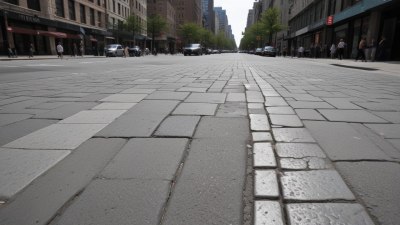How the Pavement in Some Cities Feels Like It’s Personally Attacking You
Explore how urban pavement can feel hostile, revealing the hidden challenges of navigating city streets.

This image was created with the assistance of Freepik
Urban landscapes shape our everyday experiences, with one of the most pervasive elements being the pavement beneath our feet. While many may think of pavement as a simple foundation for walking, driving, and cycling, in some cities, it seems it has developed a personality—a combative one. From cracked sidewalks that threaten your ankles to uneven surfaces that challenge your balance, the relationship between city residents and their pavement can feel like an adversarial one. This article delves into the various ways pavement can feel personally hostile, exploring the reasons behind its design, the physical and psychological impacts on residents, and what could be done to foster a more inviting urban walking experience.
The Urban Pavement Experience
To understand how pavement can feel like it is attacking you, we must first examine the various types of surfaces that make up our city streets. Sidewalks are often the frontline of this battle, where pedestrians encounter a myriad of issues. From the moment a foot hits the ground, the texture, elevation, and integrity of the pavement can dictate the quality of the user's experience. In many urban areas, cracked pavements litter the landscapes, forming hazardous conditions that require constant caution and adjustment of one's foot placement. This agitation is exacerbated in cities with poor maintenance budgets, resulting in uneven slabs that seem conspiring to trip unsuspecting pedestrians.
Invisible Dangers Beneath Our Feet
Moreover, the problems don’t just lie in the surface level but can also be the result of deeper infrastructure issues. Over time, tree roots grow beneath sidewalks, pushing up slabs and establishing a battleground for pedestrians. What may look like a harmless bump to some can become a stumbling block for others, especially the elderly or those with mobility challenges. This phenomenon illustrates that residential areas in cities are not just places to live but also landscapes fraught with dangers. The perception of hostility grows stronger when you consider how these issues are often overlooked by those in power; city management frequently prioritizes roadways and transit lines over pedestrian safety, cementing the idea that the pavement is out to get you.
The Emotional Toll of Paved Surfaces
The psychological effects of navigating hostile pavement can be profound. Every trip outside becomes fraught with anxiety. Individuals may feel a constant state of vigilance, hyper-aware of their surroundings and keenly examining the ground before taking each step. This level of tension can erode the joys of simply walking through one’s neighborhood. Instead of enjoying a leisurely stroll or a quick errand run, the focus shifts to scanning for those troublesome cracks and dangerous elevations. The sheer annoyance can quickly spiral into frustration and resentment towards the city, fostering negative feelings that can affect overall well-being. When the pavement feels like an enemy instead of a facilitator, the population’s dependence on these pathways may become a source of distress instead of an avenue for freedom.
Comparative Analysis: Cities with Good vs. Bad Pavement
Comparing cities reveals striking contrasts in how pavement design influences urban life. Cities like Copenhagen and Amsterdam, renowned for their pedestrian-friendly infrastructures, have prioritized smooth, even surfaces that compliment scenic walking routes and bustling civil life. In these areas, walking is often a joy, with people encouraged to engage with their environment rather than avoid it. Conversely, cities with heavy vehicular traffic, like Los Angeles or parts of New York, have struggled with the maintenance of pedestrian pathways. Cracks, potholes, and uneven surfaces deter pedestrians, creating an unwelcoming atmosphere. In a world prioritizing mobility and accessibility, juxtaposing these experiences emphasizes the need for improved pedestrian policies in neglected urban locales.
Innovations in Urban Pavement Design
In response to the issues presented, urban planners are beginning to explore innovative solutions to create more welcoming pedestrian environments. Ideas such as 'slash and burn' initiatives focus on prioritizing the pedestrian plane over cars, creating broader sidewalks, dedicated walking spaces, and even implementing smart pavement materials that can react to weather conditions or resist wear and tear more effectively. These innovations aim to integrate nature with urban design, forming a landscape that enhances walkability while also providing aesthetic and psychological benefits to its inhabitants. The future of urban spaces depends heavily on how we address these overlooked areas, shifting the narrative from that of a hostile pavement to a hopeful one.
The Role of Community Engagement
Local activism is critical in challenging the status quo regarding urban pavement. Community members often have the best insights into their daily navigation struggles, making their voices essential in planning processes. Cities that engage residents in discussions about infrastructure development can begin to lay better groundwork for future improvements. Neighborhood projects that promote clean-ups, physical upgrades, and beautification campaigns have gained traction across urban areas, demonstrating the power of collaboration. By shifting from a top-down approach to a community-driven philosophy, cities can begin treating their pavements as an integral aspect of urban harmony rather than an afterthought.
Rethinking Our Relationship with Urban Pavement
Redefining our interaction with city pavements is crucial for enhancing urban living experiences. As we examine the reasons behind hostile surfaces and engage with the possibilities of reform, it becomes evident that pavements tell a story of their own—one that reflects the socio-economic realities and priorities of city management. The hostility experienced when navigating cracked, uneven sidewalks need not be the narrative we accept. With community involvement, innovative design, and a commitment to pedestrian safety, we can reshape the urban landscape. A future where pavements support rather than obstruct daily life is within reach, transforming the relationship of residents with their city from one of animosity to one of partnership and empowerment.











